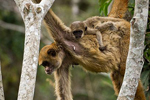Common marmoset monkeys (Callithrix jacchus) have been described as having human-like conversations according to a team of researchers from the Princeton Neuroscience Institute.
Native to Brazil, marmosets are highly social animals, using simple vocalizations in a multitude of situations: during courtship, keeping groups together and defending themselves. They also, according to the study published in Current Biology, exchange cooperative conversations with anyone and everyone – not just with their mates.
“We were surprised by how reliably the marmoset monkeys exchanged their vocalizations in a cooperative manner, particularly since in most cases they were doing so with individuals that they were not pair-bonded with,” said Asif Ghazanfar of Princeton University.
 Geoffroy’s Marmoset (Callithrix geoffroyi), close relatives of the common marmoset, waiting to respond. Photo by Rhett A. Butler.
Geoffroy’s Marmoset (Callithrix geoffroyi), close relatives of the common marmoset, waiting to respond. Photo by Rhett A. Butler.
The researchers placed marmosets on opposite ends of a room separated by a visually opaque curtain to record their “phee” calls – long distance contact calls. They found that many aspects of marmoset speech patterns are very similar to those of humans. For instance, both humans and marmosets typically wait before responding to ensure that their vocalizations do not overlap. However, marmosets wait longer before responding, resulting in a three to five-second lag versus 250 milliseconds for humans. The study states that this is largely due to their longer units of conversation, which range from a three to five-second call versus a single syllable for humans.
 Pygmy Marmoset (Cebuella pygmaea) in Amacayacu National Park, Colombia. Photo by Rhett A. Butler / mongabay.com |
While polite communication allows for others to more easily understand what is being said, for marmosets, additionally, it can reveal important social information such as gender, identity, social group, and context. For example, a 2008 study in the International Journal of Primatology concluded that loud cries are only exhibited by infant marmosets, while alarm calls are unique to adults.
This study also provides a novel explanation for the evolution of primate communication. Since humans and marmosets are separated by millions of years, their shared fundamental vocal characteristics support the hypothesis that cooperative communication is not determined by the presence of advanced cognitive skills.
Further studies on marmoset behavior could help explain how humans learn communication skills from our parents and what causes communication disorders.
“We are currently exploring how very early life experiences in marmosets – including those in the womb and through to parent-infant vocal interactions – can illuminate what goes awry in human communication disorders,” said Ghazanfar.
CITATION: Bezerra, B.M. & Souto, A. 2008. Structure and usage of the vocal repertoire of Callithrix jacchus. International Journal of Primatology, 29: 671-701.
Takahashi, D.Y., Naryanan, D.Z, & Ghazanfar, A.A. 2013 Coupled oscillator dynamics of vocal turn-taking in monkeys. Current Biology, 23: 1-7.
Related articles
Whales teach each other new feeding behavior

(05/29/2013) Humpback whales (Megaptera novaeangliae), popularly known for their majestic and alluring underwater mating songs and acrobatic breaches, have shown that they can adapt to changing prey variability by passing on new hunting techniques to each other. According to new findings in the journal Science, a team of researchers have revealed the cultural spread of new hunting techniques through a population of humpback whales over the span of 27 years.
A Tale of Two Elephants: celebrating the lives and mourning the deaths of Cirrocumulus and Ngampit

(09/30/2013) Scientists have applied a species prioritization scheme to Brazil’s diverse mammals to deduce which species should become the focus of conservation efforts over the next few years in a new paper published in mongabay.com’s open-access journal Tropical Conservation Science.
Forgotten species: the nearly extinct primate that can be shot on sight

(09/27/2013) The attention paid to charismatic popular primates—such as gorillas, chimps, orangutans, lion tamarins, and even some lemurs—could make one suppose that conservationists have the protection of our closest relatives well in hand; the astounding fact that no primate species is known to have gone extinct in the last hundred years (despite large-scale destruction of their habitats) seems to confirm this statement. However, looking more closely at the data, one finds that not only are many of the world’s primates slipping toward extinction, but a number of them have received little conservation attention. According to the IUCN Red List, a staggering 48 percent of the world’s primates are threatened with extinction: that’s a worse percentage than amphibians which have been ravaged by a global epidemic. And although a handful of the world’s 600-plus primates have garnered conservation adoration, many remain obscure.
Scientists catch boa constrictor eating a howler monkey (photos)

(09/02/2013) In a world first, scientists have captured images and video of a boa constrictor attacking and devouring whole a femle howler monkey, one of the largest new world primates weighing in at around 4 kilograms (8.8 pounds). The rare predation event was recorded in a tiny forest fragment (2.5 hectares) in the Brazilian state of Rondonia by Erika Patricia Quintino, a PhD student at the Pontifical Catholic University of Rio Grande do Sul.














